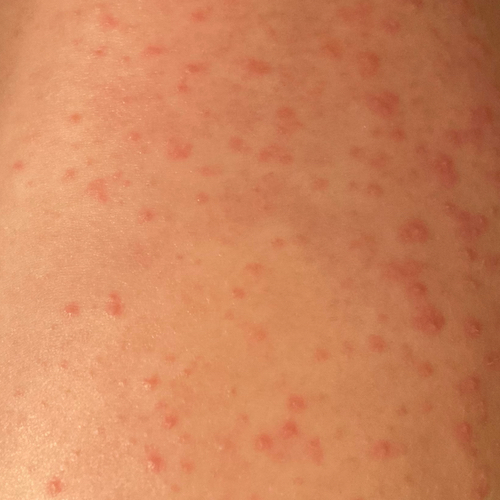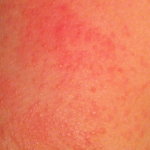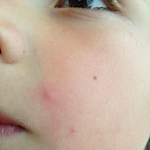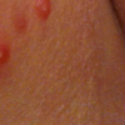
How to Use
First time use: Wait 30 minutes after washing. Apply a very small amount of Mollenol lotion as a test. This should be a thin smear, less than a drop, applied to the top of one bump with your fingertip. Wait 1 minute before continuing.
Ongoing application: Wait 30 minutes after washing. When using Mollenol, apply a very small amount, a smear only to one bump at a time - go slowly, waiting 5 seconds or so and build up more Mollenol on each bump.
Apply Mollenol only to the head of the molluscum bump. Use the tip of your little finger (best) or a q-tip.
Avoid open scratched or burst molluscum and eczema.
Shake the bottle before use. Do not remove the flow restrictor in the neck of the bottle.
After the lotion is absorbed put a Mollenol Patch or waterproof bandaid on any larger pus filled (raised) bumps. Do this once per day. Only raised pus filled bumps need a Mollenol Patch.
Additionally, undertake another round of applying Mollenol lotion to the bumps which do not have a Patch or bandaid.
Each evening after washing remove the Patches or bandaids carefully so as not to spread the pus. Wait 30 minutes after bathing to apply Mollenol lotion again.
The aim is to soften the head of the bumps. You should see inflammation of the bumps and surrounding skin.
Use Mollenol Sensitive for children 2-7 years old and for the private and sensitive parts of adults and children of all ages. Use Mollenol for children 8 years and older and adults for general application. Use our Essential Serum for infants under 2 years and for hyper sensitive areas for all ages. Mollenol Patches can be used for all ages.
When is it time to stop applying?
Do not apply Mollenol and let heal
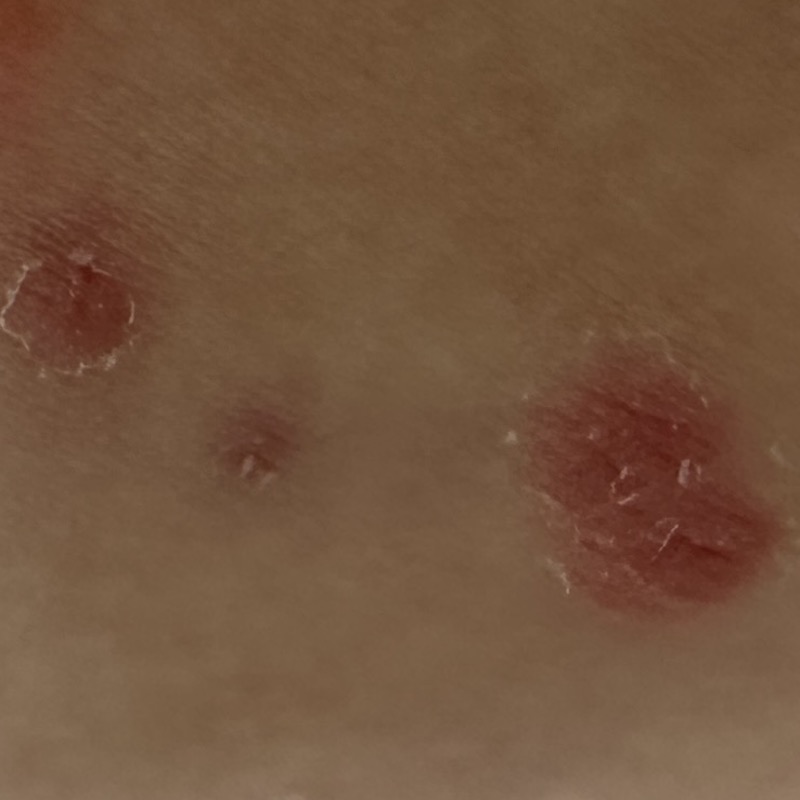
Pus has exuded and the lesion is now a wound. Keep the lesion clean and allow to heal.
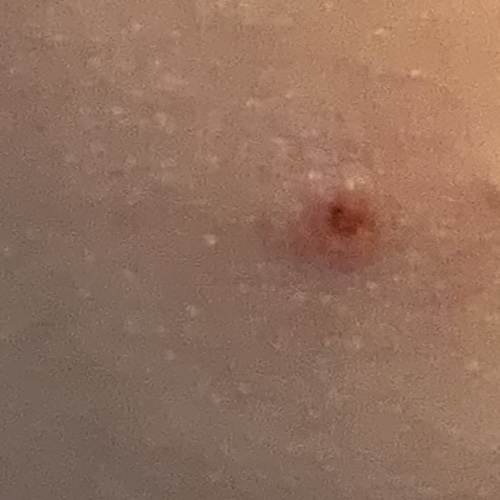
Mollenol lotion may sting especially for small children if you apply to these open, burst or scratched lesions. Don't apply Mollenol lotion or Mollenol Patches.
When the head of the lesion has opened and the pus exuded the lesion is now a “wound” and should be kept clean and left to heal with no further application of Mollenol lotion or Patches. Use antiseptic lotion and cover with a bandaid if needed and consult your doctor if signs of a bacterial infection occur.
Signs of bacterial infection are a large dark red inflammation surrounding the lesion, tender to touch, perhaps harder than normal. Sometimes pus exudes which is darker or thicker than normal pus. Blood may also exude.
Get started quickly
Cover large pus filled bumps
Cover large bumps with Mollenol lotion and Patches or bandaids. Some inflammation should occur.
Bumps can look inflamed and ugly but do not burst or pierce them.
Dab a little Mollenol full strenth lotion, Mollenol Sensitive lotion or Essential Serum (depending on the age) on each bump and apply a Mollenol Patch or waterproof bandaid to absorb and contain the pus.
The pus can cause spread and so when bumps burst or open without containing the pus spread is more common.
Preventative action must be taken.
Mollenol lotion softens and cleans the head. Mollenol Hydrocolloid Patches or bandaids effectively capture the pus.
Cluster of small bumps
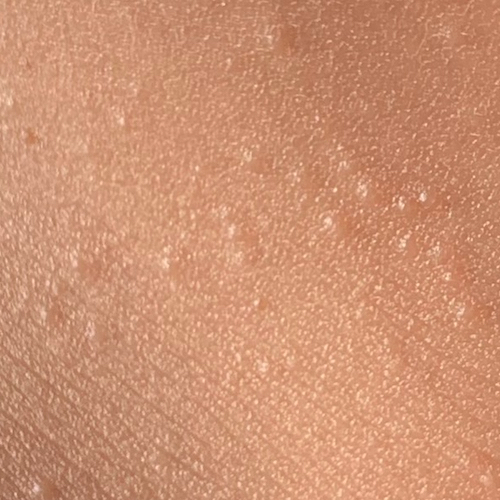
Beginning stage bumps before application of Mollenol
Cluster with small and developing bumps slightly inflamed after application of Mollenol
Clusters often appear on the torso, thighs or elsewhere.
These clusters may have larger lesions surrounded by very small, pin-sized bumps. The small bumps are early stage and may only show after Mollenol has been applied.
Apply a thin smear of Mollenol/Mollenol Sensitive or Essential Serum to the cluster.
Do not rub in. Keep covered with clothing and use Mollenol Patches or waterproof bandaids on any larger, pus filled bumps within the cluster. Patches can be overlapped to cover a larger area.
Extensive spread
From beginning (4) to burst (1) and pus-filled bumps (2 & 3)
Extensive spread can result if the issue is not treated quickly, covering large sections of the body with many lesions in various stages of growth.
The best approach is to treat the worst infected areas with Mollenol Sensitive, working through the bumps day by day. Cover as many pus filled bumps as possible with a Mollenol Patch.
Practice good hygiene, use towels only once, use a hair dryer to thoroughly dry skin.
What to expect

Developing
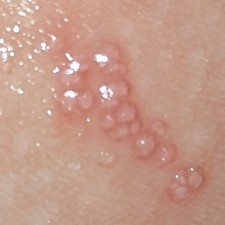
Inflammation after application of Mollenol lotion
Pus filled bumps should be covered with a Mollenol Patch or waterproof bandaid to control exuding pus matter.

Spread from the pus filled bumps across the skin now inflamed and drying after Mollenol lotion.
We expect to see some inflammation and it is generally a good sign.
Apply Mollenol lotion only to intact bumps not where the head is open or broken.
Apply Mollenol Patches or waterproof bandaids to all pus filled bumps.
More generalised inflammation looking like a rash may indicate resolution is close
From pus filled bumps to healing skin: Signs that the skin is healing
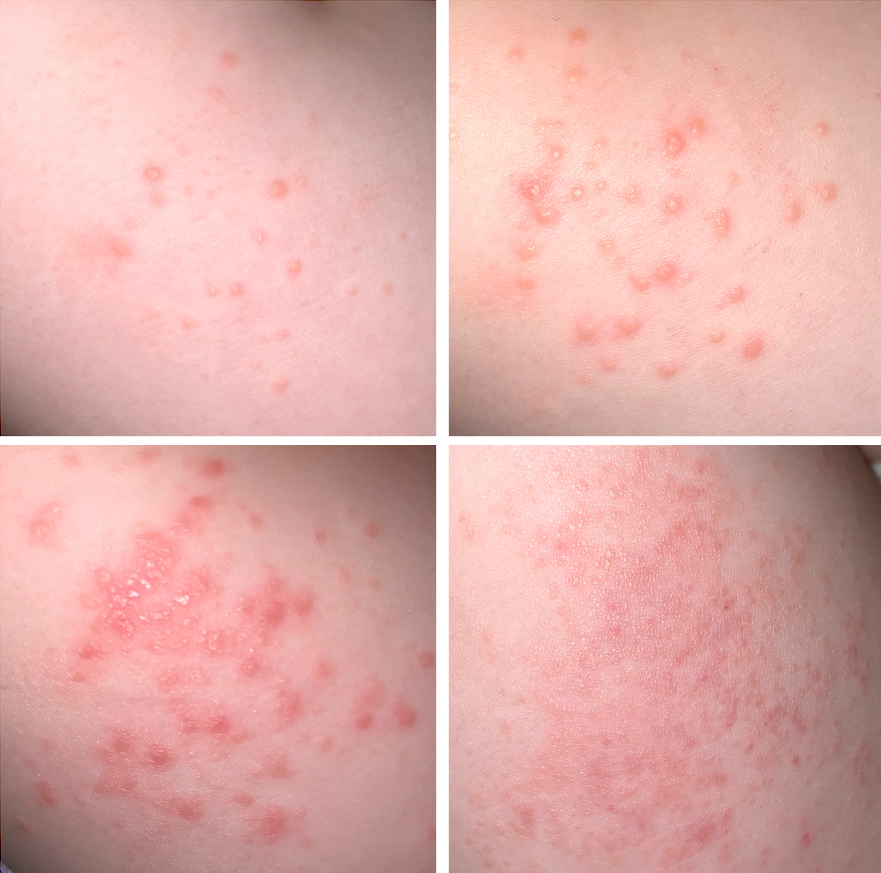
Mollenol starts to inflame the skin. Small bumps which may not have been noticed show as they inflame. (observe: L-R)
Mollenol penetrates into the bump and the bump will often inflame and perhaps enlarge. Adjacent small bumps also inflame into what looks like a rash.
Drying out or flattening of the lesions usually follow and sometimes a hard or scabbed head may develop.
The final phase is when the lesion starts to fade and the skin begins to look normal again.
Stubborn Large Bumps

Well formed and intact bumps with no inflammation are often more stubborn. The skin looks thick covering the bump and there is a lack of innate inflammation.
Some bumps do not respond quickly to Mollenol. This is because there is a thick layer of skin forming the bump.
Aim now to soften the head of the bumps to allow Mollenol to penetrate and for the pus to exude. This may be achieved by apply Mollenol Patches or waterproof bandaids for 48 hours at a time. Using more Mollenol lotion may also help. Persistence and patience will be required.
Bumps on the face
Act quickly when bumps is on the face
Dab a little Mollenol Sensitive (for children and adults) or Essential Serum (for infants) on individual bumps. Do not rub in. Be careful when applying Mollenol lotion to the face, go slowly and ensure to avoid the eyes. Apply Mollenol 2-4 times per day.
Use a Mollenol Patch or waterproof bandaid if any bumps contain pus. Mollenol Sensitive and Essential Serum should not be used on the eyelid and no closer than 1cm from the eyes.
Eczema
Look closely for scaly skin
Eczema and other skin issues often appear together.
Apply Mollenol lotion to the bumps within the eczema area.
This will help soothe and moisturise the skin, reduce itching associated with the issue and atopic skin conditions. This minimizes scratching and can help limit the spread.
Do not apply other creams or lotion when apply Mollenol.
See here for information about the use topical corticosteroids or immunomodulators.
Bumps under hair
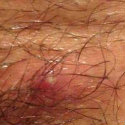

Mollenol lotion penetrates through
Bumps can lodge under hair on the head, pubic hair and under armpit hair.
Mollenol, Mollenol Sensitive and Essential Serum can be applied frequently, minimum of twice per day, to bumps in these locations.
Mollenol lotions are easy to use on hairy places.
Bumps on the genitals
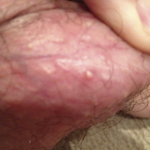
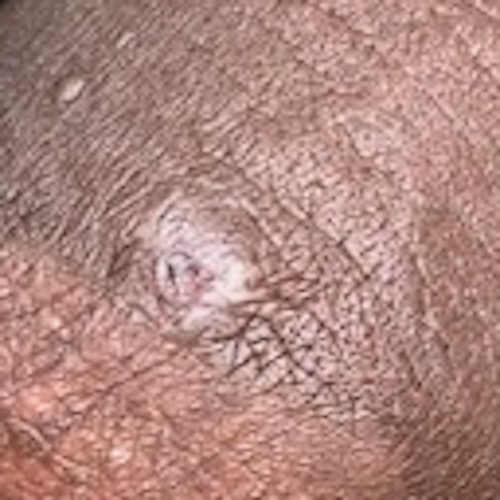
Mollenol Sensitive or Essential Serum are best for bumps on the genitals
Mollenol Sensitive or Essential Serum are best for treatment of bumps on the genitals.
Dab a very small amount to one bump at a time using a q-tip (cotton bud) or your fingertips (fingertips are best).
Ensure minimum spread to surrounding area. Go slowly and cautiously as this is a sensitive area. Wearing under-pants while applying and shifting the under-pants aside to apply will help minimise spread.
Mollenol Sensitive/Essential Serum should be applied minimum of twice per day.
Do not wax or shave pubic hair while you have these skin issues.
Signs of progress
Progression of extensive spread with many pus filled bumps using Mollenol Sensitive and Mollenol Patches.
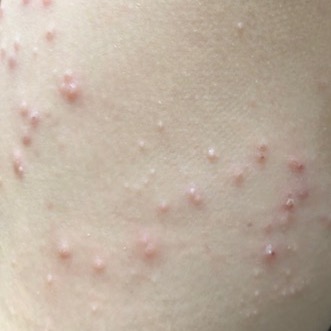
Day 1 of use of Mollenol. Some very slight inflammation of intact bumps.
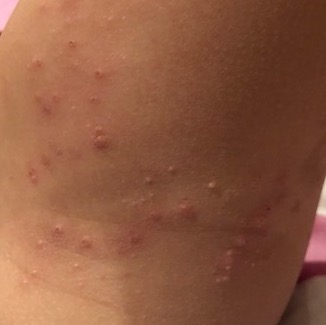
Day 4 with some bumps shrinking, others swelling, all look more irritated.
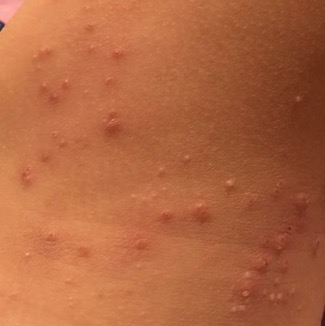
Day 7 many bumps have shrunk and are drying out, more stubborn pus bumps are showing.

Day 14 and only a handful of bumps contain pus with the skin inflamation finalising the drying process.
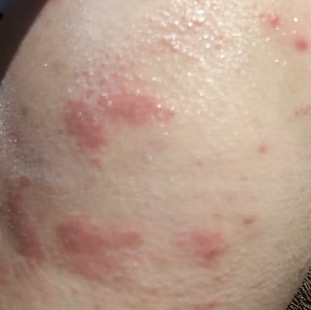
Day 17 immediately after application of Mollenol lotion areas of underlying spread are inflaming.
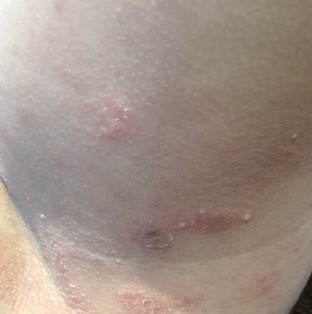
Day 20 and large area of skin is now healing but a small number of the most stubborn bumps remain.
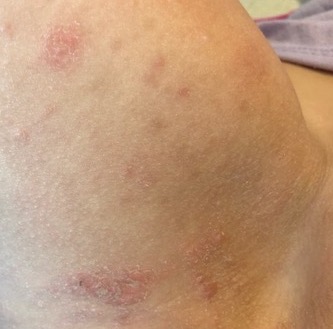
Day 25 Mollenol has done its job. Let the skin heal without any further application.

Day 35 the healing is nearly complete, only fading darker spots remain. The darker or lighter skin areas are called hypo and hyper pigmentation and are common after bumps. They may be irregular in shape or take the shape of the bump or the patch or bandaid cover. They should clear over the coming weeks.
While some people see results quickly, for others it may take longer. The average time with continuous use is around 3 weeks.
We would hope to see some signs within 14 days. The first sign is slight inflammation (redness) of and around the bump. Softening of the head of the larger bumps is also a sign of progress in the first week. You can see this softening by the bumps looking whiter or larger.
Hygiene
Some skin issues are contagious. You can spread them across your own body as well as to other people. Wash your hands often. Change pillows and clothes more frequently and bath towels daily.
Don't use soap bars, use liquid soap instead. Don't shave or wax and limit physical contact with infected areas.
Don't scratch or pierce bumps and cover any pus head bumps with Mollenol Patches, a bandaid or at least clothing. Don't share towels, toys or clothing.
*All photos submitted by people who used Mollenol. Individual results will vary.
Your Mollenol Options:
-
 NEW PRODUCTAU$37.80
NEW PRODUCTAU$37.80 -
 Sensitive areasYoung childrenRollerball applicator
Sensitive areasYoung childrenRollerball applicatorEssential Serum Spot Treatment
AU$37.80 -
 All agesBulk Discounts
All agesBulk DiscountsMollenol Hydrocolloid Patches
AU$37.80 -
 SALE30% DiscountFor Families
SALE30% DiscountFor FamiliesMollenol & Mollenol Sensitive Pack
AU$63.00AU$88.19 -
 8yrs to AdultsStrong
8yrs to AdultsStrongMollenol 25ml (0.85 fl oz)
AU$47.88 -
 SALEChildrenPrivate parts
SALEChildrenPrivate partsMollenol Sensitive 25ml (0.85 fl oz)
AU$44.10AU$47.88
FREE SHIPPING FOR TWO OR MORE ITEMS


